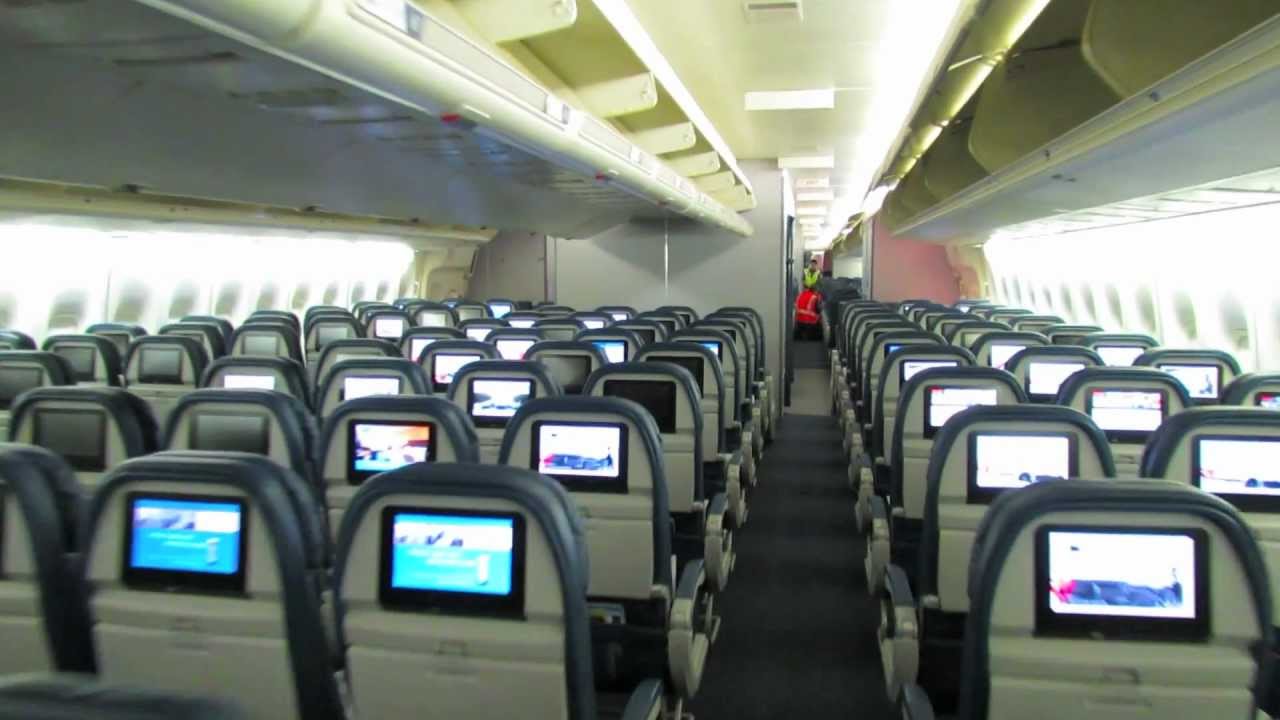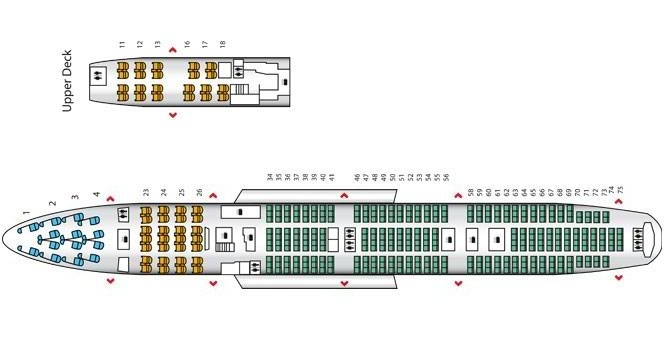Boeing 747-400 aircraft
The Boeing 747-400 airliner, which is the basis of the long-haul fleet of most major airlines, began to be produced in 1989. The production of this most popular among Boeing machines continues at the present time.
The aircraft differs from its predecessors in more advanced engines, additional fuel tanks installed in its tail section, and on-board electronic equipment. It also has vertical wingtips.
In addition to the basic version, modifications of the liner are also produced. So, the Boeing-747-400D is distinguished by an increased passenger capacity, the Boeing-747-400M is a cargo-passenger version, the Boeing-747-400F and 747-400SF are intended only for the carriage of goods. Since 2002, passenger transportation has been carried out by the Boeing 747-400ER, which has an increased flight range.
The Boeing 747-400 was discontinued in 2009. After the transfer of the last aircraft to the customer, the corporation began to manufacture a more economical and technological modification of the Boeing-747-8. As for the 747-400, this airliner is capable of flying up to 14.2 thousand kilometers. The maximum number of passengers carried by it reaches 624 people.
The fleet of major Russian airlines has Boeing-747-400 liners. These are the companies "Russia", "UTair", as well as "Aeroflot". In the last such machines appeared in 2016. 747-400 were transferred to Aeroflot from the Transaero airline.
Russian airlines offer passengers aircraft with the following cabin layout options. Four planes have 522 seats each, two have 477 seats, one plane has 461 seats. The number of passenger seats is determined by the number of seats with increased comfort. In such cases, more space is required than with the standard version.
Aircraft cabin and best seats
On the upper deck is the business class. These are rows one through three. There are no significant inconveniences to speak of here. Armchairs are easily laid out, transforming into full-fledged beds. Passengers are provided with pillows and blankets. The distance between the rows (seat spacing) is 150 centimeters.
On the same deck there is an economy class. It originates from the fifth row. In this class, on the upper deck, the seats in the fifth row are recognized as the best. There is plenty of legroom here. Armchairs are well laid out, the distance between them is 86 centimeters. So you can relax on the flight. Another plus is that almost no one moves along the aisles. Ahead is a light partition, behind which is a business class.

This is followed by rows, the places in which are standard. But the ninth row does not fall into this category. It is located next to the toilets. Passengers often move here. At the same time, they sometimes disturb those who sit in seats C and H. The latter are recognized as the most uncomfortable of all available on the upper deck. Another inconvenience is the close location of the transition connecting the upper and lower decks. Because of this transition, an uncomfortable temperature may be present.
On the lower deck, seats in rows 10 to 12 are among the most comfortable in economy class. The passengers sitting in these rows are, as it were, at some distance from the rest in the cabin. One of the advantages is the lack of noise, since there are few places in this part of the cabin. Another plus is that there is practically no movement in the aisles. Although the toilets are nearby, the queues in the aisles do not accumulate. The fact is that the toilets are located behind these rows. Comfort is provided by both the large space and the backs of the seats, which descend to a good angle.
More comfortable are places in the middle of the 18th and 19th rows. There is quite a lot of legroom here. Behind them, that is, in the 20th row, two places are uncomfortable. They are close to the toilet. In addition, due to the partition behind them, their backs recline too small.
In the 22nd row, the seats cannot be called comfortable. There is a toilet nearby. In addition, there is not much legroom due to the proximity of its wall. And another minus in this series is the lack of portholes.
Seats in row 29 do not recline. This is due to the fact that there is an emergency exit behind. Near this row is a toilet. Armchairs in the middle part of the cabin here literally rest against its backs with their backs and do not recline.
Seats in row 31 have both pros and cons. So, here, due to the fact that there is an emergency exit in front of this row, there is a large legroom. However, in such a place it is forbidden to put hand luggage on the floor. In addition, it is forbidden to fly with children and animals in this row. In addition, pregnant women, children, the elderly and foreigners who do not know English and Russian well cannot be here. Another minus - in this place is somewhat colder. Especially about places "A" and "C", next to the first there is an emergency hatch, which can interfere a little with the passenger, next to the second there is a staircase leading to the upper deck.
Seats from 32 to 42 rows can be called standard. But in the next, 43rd row, they have inconvenience. Behind is an emergency hatch. For this reason, the seat backs do not recline. There is also some constraint due to the small legroom. Passengers moving along the aisle to the toilet can also interfere.
Passengers in the 44th row have more comfort. In front of this nearby is an escape hatch. This allows you to sit comfortably as there is plenty of legroom. At the emergency exit there are seats "A" and "L". The disadvantage in this row is the proximity of the toilet.
Armchairs in rows 45 to 53 do not stand out among the standard category in terms of amenities or their absence. In the 54th row, the situation changes for the worse. The backs don't recline. The most restless places are "C" and "H", located close to the place where the flight attendants move to the kitchen.
Seats in the 55th row are comfortable, as the passengers sitting here have a lot of free legroom. However, the close location of the kitchen somewhat reduces convenience.
In three rows, 67, 68 and 69, two seats are installed. Here the atmosphere is calm and quiet. In the 70th row, the chairs are also installed in pairs. But the backs of the seats here do not recline, which makes them uncomfortable.
Nearby, where the noise is the most, is 71, located next to the toilet. At the same time, places with the lowest level of comfort are “D” and “G”. It is next to them that passengers almost constantly move.

Advantages of the Boeing 747-400 over its predecessors
Production of the Boeing 747 began in 1970. Already the first cars have become popular with both airlines and passengers. It was the first wide-body airliner.
The designers of the corporation were constantly working on improving the aircraft. It should be noted the appearance in 1980 of the Boeing 747-300, which became the largest aircraft at that time designed to carry passengers. But all the positive he had was limited to this. Technical equipment, flight range, production technologies remained at the same level. In addition, the liner was expensive to operate, and besides, this figure gradually increased.
The new Boeing 747-400 has become more advanced. The introduction of electronics made it possible to abandon the flight engineer. The crew was reduced to two people. Due to the additional fuel tank and economical engines, the range of the liner has increased. Passengers have a greater level of comfort. An entertainment system was installed for them.
Aircraft characteristics
length: 70.6 m.
Height: 19.4 m.
Wingspan: 64.4 m.
Wing area: 524.9 square meters m.
Fuselage width: 6.5 m.
Cruise speed: 910 km/h.
Flight range: 13570 km.
Number of passenger seats: 416 - 524 - 660.
Crew: 2 hours
Conclusion
The Boeing-747-400 airliner, which has occupied its niche in the air transportation market, successfully competes with wide-body Airbuses. But the aircraft created several decades ago, the most advanced for that time, will simply become obsolete if there is no modernization.
In 2005, the corporation announced that it had launched a program to develop a new liner 747-8. This will be a continuation of the development started with the production of the Boeing 737-400. Such continuity will make it possible to use interchangeable parts, as well as save on staff training.
The new aircraft will be more economical and more reliable. The noise of its engines will become quieter. Passenger amenities will also improve.
